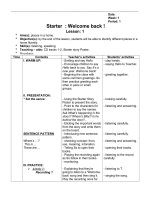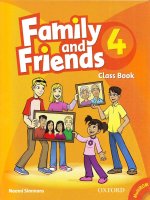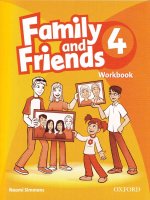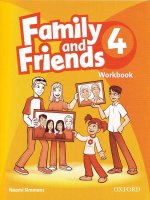family and friends 4 tuan 1214
Bạn đang xem bản rút gọn của tài liệu. Xem và tải ngay bản đầy đủ của tài liệu tại đây (87.44 KB, 8 trang )
Monday, November 13th , 2017
Week 12
Unit 3: Dinnertime!
Lesson 6: Period 45+46
I.
Aim: By the end of the lesson, students will be able to identify foods and talking
about likes and dislikes
II.
Language contents:
Vocabulary: meat, fish, rice, bread, eggs, carrots, tomatoes, ice cream, yogurt,
apple, banana, grapes, water, milk, juice
III.
IV.
Teaching aids: class book, CD tracks, flashcards
Steps of teaching:
1. Warm up: write the words: meat, bread, juice, fish, yogurt, rice, water on the
board. Give the flashcards to seven students and ask them to put the flashcards
into the right words.
2. Presentation:
Listen and draw
-
Have students look at the photo of the father and daughter
-
Tell students the girl is going to tell her dad what foods she likes and doesn’t
like
-
Ask students to listen and draw a smiley face if she likes and a sad face if she
doesn’t like
-
Play the CD for students to listen first
-
Play again and ask students to draw
Look at the menu on page 24. Ask and answer
-
Call a student to read the dialogue in the book
-
Have students work in pairs and take turns to ask and answer What do you
like?
-
Call some pairs to practise in front of the class
Circle n’t and match
-
Write isn’t, don’t, aren’t on the board and ask a student to write the long form
of these words
-
Ask student to circle n’t and match the sentences with contractions to the ones
with long forms
-
Go through and check their answers
3. Practice: Ask students to work in groups and make the menu for their own cafe.
Thursday, November 16th , 2017
Week 12
Unit 4: Tidy up!
Lesson 1: Period 47+48
I.
Aim: By the end of the lesson, students will be able to identify things in the bedroom
II.
Language contents:
Vocabulary: rug, bed, cupboard, shelf, pillow, blanket
III.
IV.
Teaching aids: class book, CD tracks, flashcards
Steps of teaching:
1. Warm up: sing Come into my house to warm up the class
2. Presentation:
Listen, point and repeat
-
Ask students about their bedrooms: What’s in their bedrooms? Is it tidy or
messy?
-
Use flashcards to elicit the words for this lesson
-
Play the CD and hold them up for students to follow
-
Have students look at their book, play the CD again for them to listen and
point the correct pictures
-
Play again for students to listen and repeat
-
Put the flashcards on the board, ask a student to come to the board and point
to the correct pictures when he/ she listens.
-
Complete with other students
-
Call some students to repeat the words
Listen and chant
-
Students join in the chant
-
Play the chant for students to listen and say the chant
-
Put the flashcards around the room, play the chant again for students to point
to the correct flashcards.
Listen and read
-
Have students look at the story in their books and ask them
Who can you see in the story?
Where are they?
What’s in the bedroom?
-
Play the CD for students to follow the words
-
Check their comprehension by asking:
Is Rosy’s room tidy?
What does Rosy do?
Why is the kitchen messy?
3. Practice: have students play a game Slap a board
Monday, November 20th , 2017
Week 13
Unit 4: Tidy up!
Lesson 2: Period 49+50
I.
Aim: By the end of the lesson, students will be able to identify things in the bedroom
II.
Language contents:
Vocabulary: rug, bed, cupboard, shelf, pillow, blanket
Structure: There’s …………, there are………….
III.
Teaching aids: class book, CD tracks, flashcards
IV.
Steps of teaching:
1. Warm up: match pictures with the words: bed, blanket, pillow, shelf, rug,
cupboard
2. Presentation:
Listen to the story again and repeat. Act
-
Ask students What is the content of the story?
-
Play the CD for students to listen again
-
Play again and pause in each sentence for them to repeat
-
Have students work in groups of three and act the story
-
Call some groups to act out in front of the class
Look and say
-
Have students look at their books at page 31
-
Call a student to say aloud the first sentence and write it on the board
-
Call another student to say the second sentence and write it on the board
-
Explain how to use There is and there are
-
Use flashcards and ask students to make the sentences using There is, There
are
Write
-
Write two gapped sentences on the board
-
Point to each sentence and ask students There is or There are?
-
Complete the sentences on the board
-
Ask students to do this exercise in their books
-
Go and check their answers
Look at the pictures again. Point, ask and answer
-
Call a student to read the dialogue
-
Have students work in pairs to ask How many….? And answer There is ….,
There are….
-
Call some pairs to say aloud in front of the class
3. Practice: students turn back to the story on page 30. They take turn to tell each
other about things they can see.
Thursday, November 23rd
Week 13
, 2017
Unit 4: Tidy up!
Lesson 3: Period 51+52
I.
Aim: By the end of the lesson, students will be able to identify numbers from 11-20
II.
Language contents:
Vocabulary: eleven, twelve, thirteen, fourteen, fifteen, sixteen, seventeen, eighteen,
nineteen
III.
IV.
Teaching aids: class book, CD tracks, flashcards
Steps of teaching:
1. Warm up: ask students count from one to ten
2. Presentation:
Listen, point and repeat
-
Use flashcards to introduce numbers from 11-20
-
Play the CD, hold them up for students to follow
-
Have students look at their books at page 32
-
Play the CD again, ask them to listen and point to the correct numbers
-
Play again for students to listen and repeat
-
Call some students to repeat numbers
-
Give each student a flashcard and ask he/ she to raise it up when she/ he
listens
Listen and sing
-
Introduce the song to students There are ten in the bed
-
Ask students Where is she?
-
Play the song for students to follow
-
Play again but pause in each line for them to repeat
-
Play again and ask students to sing along with the CD
Sing and do
-
Tell students they will listen to the song again but this time they will do the
actions
-
Model some actions
-
Play the song again for students to sing and do the actions
3. Practice:
Monday, November 27th , 2017
Week 14
Unit 4: Tidy up!
Lesson 4: Period 53+54
I.
Aim: By the end of the lesson, students will be able to say phonics /i/
II.
Language contents:
Vocabulary: bin, fig, tin
III.
IV.
Teaching aids: class book, CD tracks, flashcards
Steps of teaching:
1. Warm up: sing the song There are ten in the bed to warm up the class
2. Presentation:
Listen, point and repeat
-
Hold up the bin, fig, tin phonics cards and play the CD for students to follow
-
Ask students What they think today’s letter is
-
Have students look at their books, play the CD again for them to listen and
point
-
Play again for them to listen and repeat
-
Call a student to say the phonics again
-
Call some students to repeat the words
Listen and chant
-
Play the chant and have students join in the chant
-
Put the flashcards around the room, play the chant again and ask students to
point to the correct flashcards
Read the chant again. Circle the i in the middle of the words
-
Have students look at the chant again and ask them to circle the i in the middle
of the words
-
Model the first word
-
Ask students to do this exercise
-
Go through and check their answers
Listen to the song and join the letters
-
Play the CD for students to listen and link the letters to find out what is in the
bin?
-
Play the CD again for students to check the answer
-
Write the letters on the board
-
Call a student to come to the board, play the CD again for her/ him to link the
letters.
3. Practice: write the words bin, tin, fig on the board. Ask students to work in
groups and find more words with /i/. The group who can find more words win the
game.
Thursday, November 30th , 2017
Week 14
Unit 4: Tidy up!
Lesson 5: Period 55+56
I.
Aim: By the end of the lesson, students will be able to identify things in a bedroom.
II.
Language contents:
Vocabulary: shelf, cupboard, rug, bed, pillow, blanket
III.
IV.
Teaching aids: class book, CD tracks, flashcards
Steps of teaching:
1. Warm up: play a game What’s missing to revive house and bedroom words
2. Presentation:
What’s in the bedroom. Point and say
-
Ask students to look at the picture of the bedroom and the photo of the boy
-
Ask students
What’s his name?
What is the text about?
What does Jamie like?
-
Have students work in pairs and take turn to point to different bedroom
objects and say the words
Listen and read
-
Have students look at the text in their books
-
Play the CD for them to follow the words
-
Play the CD again but pause in each sentence for them to repeat
-
Call some students to read the text again
-
Have students work in groups and check their comprehension:
How many beds in his bedroom?
Are there lots of footballs on his blanket and pillow?
How many books on his shelf?
What is his favourite clothes?
Does he like his bedroom?
Read again. Write True (T) or False (F)
-
Write the first sentence on the board
-
Have students read the text again, ask them Is the sentence true or false?
-
Write the letter next to the sentence
-
Ask students to do this exercise in their books
-
Go through and check their answers
3. Practice: have students play a game Words search









